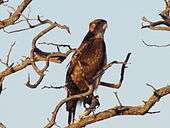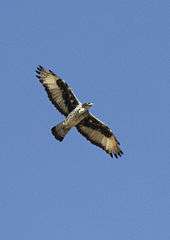African hawk-eagle
| African hawk-eagle | |
|---|---|
.jpg) | |
| Damaraland, Namibia | |
| Scientific classification | |
| Kingdom: | Animalia |
| Phylum: | Chordata |
| Class: | Aves |
| Order: | Accipitriformes |
| Family: | Accipitridae |
| Genus: | Aquila |
| Species: | A. spilogaster |
| Binomial name | |
| Aquila spilogaster (Bonaparte, 1850) | |
 | |
| Synonyms | |
| |

The African hawk-eagle (Aquila spilogaster) is a large bird of prey. Like all eagles, it belongs to the family Accipitridae. The African hawk-eagle breeds in tropical Sub-Saharan Africa. It is a bird of wooded hills, building a stick nest about 3 feet (almost 1 metre) in diameter in the fork of a large tree. The clutch is generally one or two eggs. The African hawk-eagle hunts small mammals, reptiles, and birds. The call is a shrill kluu-kluu-kluu.[2]
Description

The African hawk-eagle is a small to medium-sized eagle at about 55–65 centimetres (22–26 in) in length. The upper parts are blackish. Its underparts are white heavily streaked with black. The underwing flight feathers are white with a black trailing edge. The underwing coverts are mostly black with white spots. Sexes are similar, but young birds are brown above and rufous coloration replaces the black underparts of the adult.[2] It was noted in a 2010 study that you could possibly distinguish a male and female adult due to the fact that the female tends to be more heavily marked below than a male. They can easily be confused with the Ayres's Hawk-Eagle however in flight, the Ayres lacks the white windows on the primaries and tends to be smaller with a nuchal crest. Their underparts are also more heavily streaked than that of the African hawk-eagle[3]
Distribution and habitat

The African hawk-eagle is found in large parts of Africa south of the Sahara. It occurs in Angola, Benin, Botswana, Burkina Faso, Burundi, Cameroon, Central African Republic, Chad, Democratic Republic Congo, Eritrea, Ethiopia, Gambia, Ghana, Guinea, Guinea-Bissau, Ivory Coast, Kenya, Malawi, Mali, Mauritania, Mozambique, Namibia, Niger, Nigeria, Rwanda, Senegal, Sierra Leone, Somalia, South Africa, South Sudan, Sudan, Swaziland, Tanzania, Togo, Uganda, Zambia and Zimbabwe.[1]
This is a bird of well-wooded countryside which does not occur in forests.[2] They can inhabit sparse savanna, semi-desert areas to tall broad-leaved woodland and avoid evergreen forests and mountainous areas. They have however been known to nest on cliff faces which is counter-intuative[3]
Status
The African hawk-eagle is often seen in pairs. It has a very wide range and is a relatively common species. No particular threats have been identified but the population is thought to be declining slowly. The International Union for Conservation of Nature has rated its conservation status as being of "least concern".[1] A 2006 study found that the African Hawk Eagle, among other raptor species have been declining at high rates outside of protected areas and only seem to be stabilizing through the efforts of national parks[4]
Diet and Hunting
The African Hawk Eagle's primary hunting tool is its feet. They tend to hunt either from a perch or from the air and can see prey up to 1 km away. Their prey of choice tends to be birds and they often flush gamebirds such as spurfowl and guineafowl out of dense vegetation. It has been found that a pair of eagles can hunt cooperatively with one bird flushing and the other waiting nearby to strike. Other prey items include small mammals and occasionally reptiles and insects.[3]
Breeding
This species is monogamous and typically places its nest (in the form of a large platform) below the canopy of tall trees and the nest is built by both the male and female. They have also been known to roost on man-made structures such as pylons. Nests have been known to have been used for up to 60 years in some cases. Their courtship routine involves the pair soaring and calling above the nest. In many cases, the male will dive towards the female and the female, in turn, turns to the male and displays her claws. This mating ritual culminates in the male presenting the female with nuptial gifts in the form of prey. Eggs are laid in clutches of 1 to 2 between April and August. Incubation lasts around 43 days with both parents being involved.[3] In a study conducted in Zimbabwe in 1988, 116, African Hawk-Eagle pairs were assessed in terms of breeding success in two areas of varying substrate quality. It was found that nests were placed in flat-crowned thorn trees in areas with basaltic soils and round-crowned, rough-barked trees in areas with sandy soil. Rainfall affected breeding success, laying dates and the sizes of clutches with higher success, later laying dates and larger clutch sizes correlating with higher rainfall. More breeding attempts were made in open woodland areas than in closed however the number of resulting chicks did not differ between vegetation structure.[5]
Siblicide
A 2008 study found that the first-born chick in a nest will crush, acquire more food than, and inevitably kill the second, smaller chick. This is a common occurrence in many bird species which allows for a chick to thrive and in the unlikely event that the first chick dies, there will be the second chick to propagate the species.[6] According to a 1959 study, the instinct for two chicks to fight subsides after a few weeks thus if the second chick manages to survive for that long, the chances that it will fledge will be increased. The same paper suggests that intrabrood cannibalism likely follows a siblicide event.[7]
Young birds
When the chicks are newly hatched, they are altricial and are unable to preen, hunt, move in a coordinated fashion and fly. At 5 days old, they are able to preen itself and by 11 days can move around the nest. Only at the age of 24 days can the chicks defend the nest however cannot tear meat off of the food that a parent provides. Young eaglets spend a great deal of the day sleeping and most awake activity involves preening and feeding. At 50 days of age, the chicks show signs of fledging through being able to feed themselves and through flapping their wings. A bored chick will often nibble the nest, practice pouncing on sticks and play with bones. These activities are said to improve coordination.[8]
References
- 1 2 3 BirdLife International (2012). "Aquila spilogaster". IUCN Red List of Threatened Species. Version 2016.2. International Union for Conservation of Nature. Retrieved 2 November 2016.
- 1 2 3 Simmons, R.E. "Aquila spilogastra" (PDF). Atlas of Southern African Birds. Retrieved 2 November 2016.
- 1 2 3 4 Roberts VII Multimedia Birds of Southern Africa
- ↑ THIOLLAY, JEAN-MARC (2006-04-13). "The decline of raptors in West Africa: long-term assessment and the role of protected areas". Ibis. 148 (2): 240–254. doi:10.1111/j.1474-919x.2006.00531.x. ISSN 0019-1019.
- ↑ Hustler, K.; Howells, W. W. (1988). "The Effect of Primary Production on Breeding Success and Habitat Selection in the African Hawk-Eagle". The Condor. 90 (3): 583–587. doi:10.2307/1368346. JSTOR 1368346.
- ↑ Meyburg, Bernd-Ulrich (2008-04-03). "SIBLING AGGRESSION AND MORTALITY AMONG NESTLING EAGLES". Ibis. 116 (2): 224–228. doi:10.1111/j.1474-919x.1974.tb00243.x. ISSN 0019-1019.
- ↑ Ingram, Collingwood (1959). "The Importance of Juvenile Cannibalism in the Breeding Biology of Certain Birds of Prey". The Auk. 76 (2): 218–226. doi:10.2307/4081778. JSTOR 4081778.
- ↑ Steyn, Peter (2010). "Observations on the African Hawk-Eagle". Ostrich. 46: 87–105.
- Barlow, Wacher and Disley. Birds of The Gambia. ISBN 1-873403-32-1
- Collinson, M. Splitting headaches? Recent taxonomic changes affecting the British and Western Palaearctic lists. British Birds vol 99 (June 2006), 306-323
- Lerner, H. R. L. and D. P. Mindell. (2005) Phylogeny of eagles, Old World vultures, and other Accipitridae based on nuclear and mitochondrial DNA. Molecular Phylogenetics and Evolution (37) 327–346.
